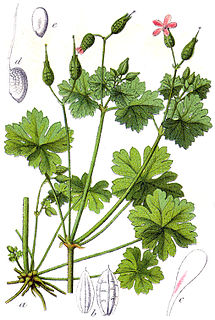
Geranium lucidum, commonly known as shining cranesbill or shining geranium or shiny geranium, is a herbaceous annual plant of the genus Geranium. It is native to Europe, western Asia and North Africa. It has been introduced to North America as a garden plant and in places, particularly the Pacific Northwest, has become naturalised and is viewed as an invasive species and noxious weed.

Geranium potentilloides, belongs to the family Geraniaceae, and is a small prostrate perennial herb that can grow up to 60cm high. The species is commonly referred to as Soft Cranesbill or Cinquefoil geranium.

Pelargonium peltatum is a scrambling perennial plant with shallow or deeply five lobed, circular to heart-shaped, somewhat fleshy leaves, sometimes with a differently coloured semicircular band, that has been assigned to the cranesbill family. It carries umbel-like inflorescences with 2–10, white to mauve, bilateral symmetrical flowers, each with a "spur" that is merged with the flower stalk. It is known by several common names including ivy-leaved pelargonium and cascading geranium. It is native to southern and eastern South Africa. In its home range, it flowers year round but most vigorously from August to October.
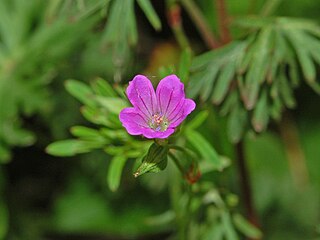
Geranium columbinum, common name long-stalked crane's-bill or longstalk cranesbill, is a herbaceous annual plant in the family Geraniaceae.

Acacia burkittii is a species of wattle endemic to Western Australia, South Australia and western New South Wales, where it is found in arid zones, and is a perennial shrub in the family Fabaceae. Common names for it include Burkitt's wattle, fine leaf jam, gunderbluey, pin bush and sandhill wattle. It has also been introduced into India. Previously this species was referred to as Acacia acuminata subsp. burkittii, but is now considered to be a separate species. Grows in mallee, eucalypt and mulga woodland or shrubland, often on sandhills.

Hakea rostrata, common name beaked hakea, is a flowering plant in the family Proteaceae, native to South Australia and Victoria.
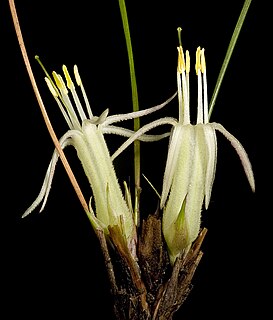
Conostylis androstemma is a tufted perennial plant species in the family Haemodoraceae. It is endemic to the south-west of Western Australia. Plants grow to between 10 and 30 cm high and produce cream to pale yellow flowers between May and August in the species' native range.

Scaevola argentea, is a low growing, branching shrub in the family Goodeniaceae.

Scaevola acacioides, is an erect, spreading shrub in the family Goodeniaceae.

Scaevola basedowii is an erect multi-stemmed shrub in the family Goodeniaceae, endemic to Western Australia, the Northern Territory and South Australia.

Scaevola humifusa is a prostrate shrub in the family Goodeniaceae, native to Western Australia. It grows to a height of 0.01 to 0.5 m, and its white-cream/white-blue flowers may be seen from August to November or January.

Scaevola parvifolia is an erect, many stemmed perennial in the family Goodeniaceae, which is native to Western Australia, the Northern Territory, Queensland and South Australia. It grows to a height of 0.6 m, and its blue-purple flowers may be seen from March to October.
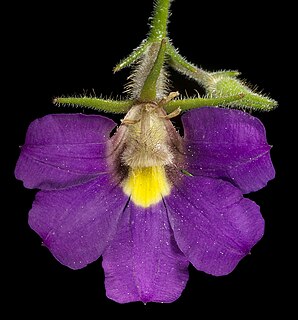
Scaevola phlebopetala, commonly known as velvet fanflower, is a herb in the family Goodeniaceae and is endemic to Western Australia.

Scaevola repens is a shrub in the family Goodeniaceae, endemic to the south west of Western Australia.
Amyema plicatula is a species of hemi-parasitic shrub found in the Bismarck Archipelago, New Guinea, New South Wales and Queensland.

Beyeria lechenaultii is a species of dioecious flowering plant in the spurge family, Euphorbiaceae, that is endemic to Australia.
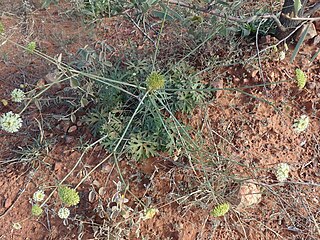
Trachymene ochracea is a herb in the family Araliaceae. It is native to Australia and found in New South Wales and Queensland.

Dampiera alata is a plant in the family Goodeniaceae, native to Western Australia.

Coopernookia strophiolata is a shrub in the Goodeniaceae family, endemic to Australia and found in both Western Australia and South Australia.
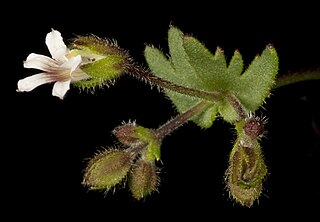
Goodenia cycnopotamica is a plant in the Goodeniaceae family which is endemic to Australia, and found in both South Australia and Western Australia





















